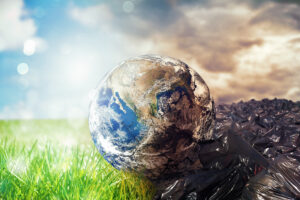***Take 20% off full price purchases*, use code summer24
***Take an extra 5% off products already on sale*, use code XTRA5
*Full details.
Plus, FREE shipping sitewide!
Microplastics in Bedding: Small Particles, Big Problem
- posted by Jack
- | September 11, 2022
In recent years, polyester and other synthetic fabrics have come to make up the lion’s share of the textile industry. About 60 percent of the clothing made today is made out of plastic. It’s more than likely that your conventional mattress pads, pillows, and even mattresses are made of a kind of plastic material too. This should be no surprise. Plastic based fabrics and fibers, such as polyester, nylon, or acrylic are fairly durable for as cheap as they are. That low price point is the major factor in the proliferation of synthetic fabrics/fibers, but cheap materials tend to have unseen costs. The environmental toll of polyester and its associated compounds have only come to be recently understood and what has been discovered should be enough to make you question your choice in bedding.
Plastics have a nasty habit of sticking around. Unlike natural materials like cotton or wool, plastics can take hundreds  of thousands of years to break down. The way we usually imagine the toll this takes on our earth is by picturing piles of intact plastic bottles filling our landfills and reaching to the sky. But plastic products do break down, albeit in a much more destructive way. By a combination of solar radiation, tidal forces, and other erosive factors, larger plastic items, such as bottles, or even blankets can break down into what are called microplastics.
of thousands of years to break down. The way we usually imagine the toll this takes on our earth is by picturing piles of intact plastic bottles filling our landfills and reaching to the sky. But plastic products do break down, albeit in a much more destructive way. By a combination of solar radiation, tidal forces, and other erosive factors, larger plastic items, such as bottles, or even blankets can break down into what are called microplastics.
Microplastics are plastics, but much, much smaller, hence the name. The dangerous thing about microplastics is that they can become so small that they can begin to end up unknowingly swallowed by marine wildlife, or even passing through filters on the way to your tap. They’re so prolific that scientists have even found them falling in rain and simply drifting through the air. Because plastics take a long time to break down, these particles are able to stick around and potentially build up in the organisms that consume them.
Experts haven’t come to a consensus on the long term health costs of this build up in humans, but they do know it’s happening, and that it’s probably not good. In the Netherlands and UK, scientists discovered microplastics in both donor blood reserves and inside the lungs of surgical patients. Some studies have found it difficult to even find live subjects to test that are clean from any microplastics. The build up of microplastics could cause all kinds of problems in the long term to soft tissues in the body, it’s just hard to tell exactly what that will be.
This proliferation is all the more concerning given that plastics are not always made to be non-toxic. A recent analysis at the Institute of Environmental Engineering in Zurich, Switzerland into the various chemicals that make up plastic compounds identified 10,000 distinct chemicals that could be present in plastic compounds. The same analysis identified 2,400 of these of “potential concern” given their toxicity. And none of this even factors in the 8,681 other chemicals that make up additives for flexibility or color. Additives which can leach into groundwater, or more worryingly, into our bodies.
The textile industry’s push toward synthetic fabrics has only contributed to the issue of microplastics. Polyester, nylon, and other plastic-based fabrics are especially prone to producing loose plastic particles. In fact, it’s thought that 35% of the microplastics found in the ocean come from textiles. And it’s likely that washing clothing or bedding made from polyester or other synthetic fabrics is enough to begin proliferating these particles into the environment. The washing process tends to erode textile products ever so slightly each time. This is a much expedited process compared to hard plastics, as your blanket doesn’t have to make it all the way to the ocean to start breaking down into tiny fibers. Purely cotton or wool products break down in the wash too, but since those products are biodegradable, the toll is not nearly so dire.
 So, once again, it’s clear the benefit of buying organic bedding isn’t just that it’s likely higher quality, it’s also better for the earth, and perhaps your long term health. Polyester and the like are cheap, yes, but organic cotton and wool are substantially less costly in the long run. The price tag on polyester just isn’t worth the lung-full of plastic fibers.
So, once again, it’s clear the benefit of buying organic bedding isn’t just that it’s likely higher quality, it’s also better for the earth, and perhaps your long term health. Polyester and the like are cheap, yes, but organic cotton and wool are substantially less costly in the long run. The price tag on polyester just isn’t worth the lung-full of plastic fibers.
There are so many other options beyond plastic fabrics and fibers when choosing bedding for yourself. Skip the polyester-packed pillows for organic pillows filled with cotton, wool, natural rubber, kapok, or even buckwheat hulls. Avoid sleeping like a potato chip by ditching the polyester mattress pads, comforters, blankets, and sheets for bedding made with 100% organic cotton and wool. And, if you’re in the market for a new organic mattress, why not look for an organic wool, cotton, or natural rubber model? Organic all-natural materials have a great variety to suit your preferences of comfort, all the while having a much lower impact on the environment and your health.
